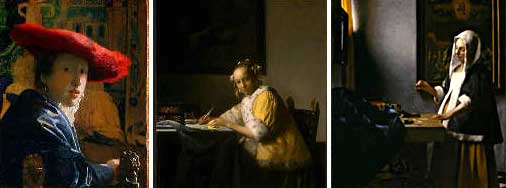Above all, Vermeer was a painter of light. In his study of optics he undoubtedly used a camera obscura, or “darkened chamber,” the ancestor of the modern photographic camera. This scientific device employed an adjustable lens and mirrors to capture reflected light and project the scene onto a viewing screen in its lid. Vermeer analyzed the resulting images carefully because they duplicate the selective focus of the human eye. Only objects at a certain distance from the camera or the eye are in sharp focus. This is exactly the optical effect Vermeer has generated here. Precise white highlights glisten from the writing box, pearl earrings, satin hair ribbons, and the chair’s brass tacks—all of which lie equally in the middle distance. The near tablecloth is purposely blurred, and the painting on the far wall is hazy. This is just as they would look to someone concentrating specifically on the woman. Because she directly faces the viewer with an open gaze, the painting may be a portrait. The Vermeer Web feature contains more information about the artist and his work.
LEFT: Johannes Vermeer, Girl with the Red Hat , c. 1665/1666, National Gallery of Art, Andrew W. Mellon Collection MIDDLE: Johannes Vermeer, A Lady Writing, c. 1665, National Gallery of Art, Gift of Harry Waldron Havemeyer and Horace Havemeyer Jr., in memory of their father, Horace Havemeyer RIGHT: Johannes Vermeer, Woman Holding a Balance, c. 1664, National Gallery of Art, Widener Collection
|
